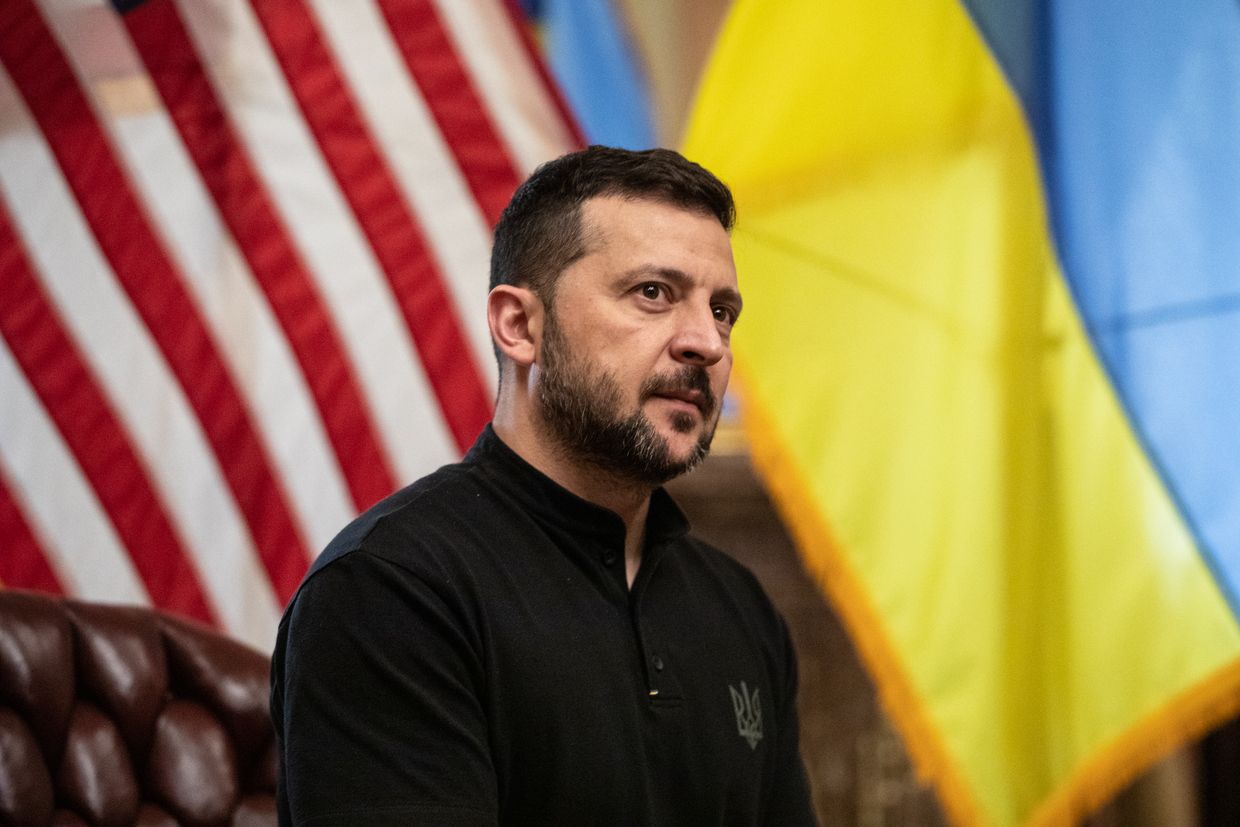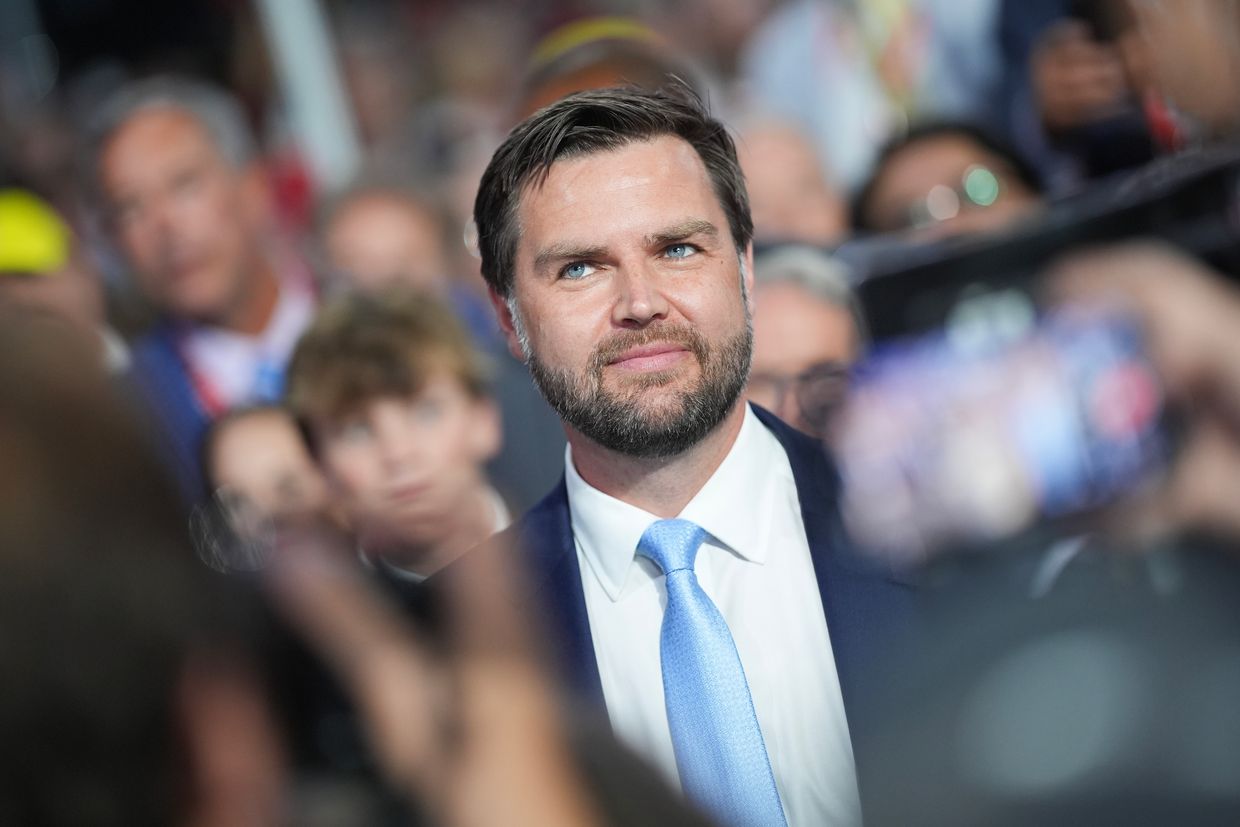
Opinion: What a Trump presidency could look like for Ukraine
Republican presidential candidate, former U.S. President Donald Trump points to the crowd during the second day of the Republican National Convention at the Fiserv Forum in Milwaukee, Wisconsin, USA on July 16, 2024. (Andrew Harnik/Getty Images)

Doug Klain
“Trump will end the Ukraine war.” This message greeted the audience just before U.S. Senator J.D. Vance emerged to accept his party’s nomination for the vice presidency. With Republican presidential candidate Donald Trump aiming to retake the presidency after the November elections, his stance on Ukraine and Russia dominates discussion about the war.
A key conversation occurred when President Volodymyr Zelensky called Trump to wish him well after an attempt on Trump’s life and to congratulate him on being the Republican nominee.
Trump later posted on social media that he would “bring peace to the world and end the war” and that “both sides will be able to come together and negotiate a deal that ends the violence and paves a path forward to prosperity.” Little change, then, from what he’s said about Ukraine in recent months, and further confirmation that he will push for Ukraine to negotiate with Russia.
Unless Trump and his running mate undergo remarkable ideological transformations in the coming months, the prospect of Ukraine being reliant on the former president for military assistance is cause for alarm.
Two prevailing predictions have emerged among policymakers and experts in Washington. One suggests Trump may not be detrimental to Ukraine, citing significant wins during his first administration, top Trump officials advocating that defeating Russia is in U.S. interests, and foreign policy consistency across administrations. The other predicts Trump will abandon Ukraine, following through on his pledge to end the war “in 24 hours.”
As the U.S. presidential election’s dynamics shift with President Joe Biden passing the Democratic nomination to Vice President Kamala Harris, it’s essential to examine how a Trump-Vance administration might approach Ukraine.
Different motivations have been suggested for Trump allowing the April supplemental aid package to pass through Congress, including that most Americans want to see Ukraine win, and Trump doesn’t want to jeopardize his re-election by drawing attention to an unpopular position. Another explanation is that then-U.K. Foreign Secretary David Cameron convinced him that opposing aid in April could lead to Kyiv falling during his possible administration in 2025, an immediate stain on a second Trump presidency.
Pro-Ukraine Republicans point to wins under Trump’s first administration as evidence that he could continue aid. A memo assembled by the powerful Republican chairmen of the Foreign Affairs, Intelligence, and Armed Services Committees in the House of Representatives points first and foremost to the provision of Javelin anti-tank systems to Ukraine in 2018, as well as landmark sanctions on Russia and Nord Stream 2 during Trump’s first term. They neglect to mention that it took months of convincing for Trump to agree to sending Javelins, and even then he asked that it be played down for fear of provoking Russian President Vladimir Putin – not to mention his effort in 2019 to use the missiles as leverage to coerce Ukraine into opening a phony investigation into U.S. President Joe Biden.
Those who expect a pro-Ukraine Trump administration hope to see the Trump-Vance campaign publicly recognize the clear U.S. national interests in standing up to Russia, as well as recognize the likely political rewards such as glowing opinion polls and potential votes in November for pledging to ensure Ukraine wins and Putin loses.
During his first term, Trump showed a willingness to push the norms of American foreign policy, such as when he ordered the assassination of Iranian General Qasem Soleimani, threatened nuclear use against North Korea, and pushed European allies into spending more on defense. With Putin’s belligerence and criminality, there’s a chance that Trump could be willing to go toe-to-toe with Moscow just as he did with Tehran and Pyongyang to secure another win for America.
Whether he fulfills a more ceremonial role as vice president like Mike Pence or carves out a powerful position like Dick Cheney, Vance’s views on Ukraine will still matter.
While Vance’s record as a staunch opponent of aid to Ukraine is both clearer and more recent – after all, it garnered him a rapid endorsement from Russia’s top diplomat – some remain hopeful that being elevated to the national stage will cause him to reconsider his views of Ukraine. Just as U.S. House Speaker Mike Johnson evolved from an opponent of Ukraine aid to an advocate who seems to truly understand the reality that Russia plans to invade NATO members if it succeeds in Ukraine, Vance’s views could similarly change.
This view of a potential Trump-Vance administration is optimistic, and it largely relies on the hope that Trump and Vance might suddenly change who they are and what they believe. There were significant expectations that when Trump first came into the presidency in 2017, the weight of the office would change him for the better. It did not.
Despite what Trump’s administration did for Ukraine, his record with Russia is troubling, to say the least. He believes Putin’s choice to invade Ukraine was “genius,” gave highly classified intelligence to Russian Foreign Minister Sergei Lavrov, and has been remarkably consistent over the years in his admiration of Putin—including his declaration that Putin was more trustworthy than U.S. intelligence agencies warning about the threat Russia posed. The wins seen under his administration were, more often than not, driven by foreign policy professionals rather than Trump himself—and it’s unclear whether those “adults in the room” will return for a second administration.
According to those who have spoken with Trump in recent months, such as Hungarian President Viktor Orban, a return to the White House would see him enacting “well-founded plans” to rapidly demand peace talks between Ukraine and Russia and that he “won’t give a penny” to Ukraine. Trump himself has declared he will end the war by pushing for negotiations, perhaps even between winning the election in November and taking office in January next year. How he’ll accomplish this is an open question but reports this year have been consistent about his reported plans.
The clearest answer came in June when Reuters reported the authors of an America First Policy Institute report had briefed Trump on their proposal to coerce Ukraine into trading away its territory and people, the promise of NATO membership, and more in exchange for merely a ceasefire with Putin. He would do so by threatening to withhold military aid, with the potential of replicating the dire days during Congress’s 2023-2024 delay in aid when Ukrainian forces had to ration dwindling supplies of ammunition and Russia faced its best conditions yet on the battlefield. The proposal also suggested that if Russia refused to come to the table, Trump could instead boost aid to Ukraine to coerce Moscow. The assumptions that underpin the entire proposal dangerously misread Russia’s war aims and the threat facing the Euro-Atlantic community.
While Putin has repeatedly suggested his openness to a ceasefire in recent months, Western leaders such as U.S. Secretary of State Antony Blinken say freezing the lines of contact would simply allow Putin to “consolidate control over the territory he has seized, and rest, rearm, and re-attack,” something former Russian President Dmitry Medvedev has openly endorsed. This would be little more than a rehashing of the failed Minsk agreements, which Russia repeatedly and brazenly violated.
If Trump wanted to assuage the fears of Ukraine’s many friends, he could get more specific about his plans for negotiations and make clear he understands Russia’s campaign to eradicate the Ukrainian identity on all territory it occupies through force. A clear way to achieve the just peace Trump says he wants is by forcing Russia to withdraw from Ukraine’s sovereign territory, return Ukraine’s stolen children, and give the Kremlin a shot at returning to the international community through reparations. Trump could also publicly endorse an approach that prioritizes arming Ukraine, deterring Russia, and ensuring Ukraine joins NATO and the EU – such as the one outlined recently by former Secretary of State Mike Pompeo.
While support for Ukraine in Congress remains strong and bipartisan, the U.S. president has remarkable control over foreign policy and America’s support for Ukraine in particular. The primary tool for supplying military assistance to Ukraine, the Presidential Drawdown Authority (PDA), is at his discretion. One tool the Trump team hopes to rely on is restoring the power of impoundment, a presidential power to withhold congressionally appropriated funds. It’s something that could be used to stop aid to Ukraine or potentially to redirect it to other national security priorities.
One source for hope, should Trump and Vance be open to working with Moscow to coerce Ukraine into an unfavorable ceasefire, is that a potential Trump administration is likely to be consumed by internal chaos in its opening months. Trump and his team have been clear that a top priority would be enacting retribution against his perceived enemies as well as remaking the machinery of the U.S. government by replacing thousands of civil servants with political appointees who have been vetted in advance for their loyalty to Trump. Particularly after trying to steal the 2020 election and overthrow the U.S. government in 2021, the former president and his allies have been unambiguous about the fact that their anti-democratic aspirations will be the top priority should Trump return to the White House.
As crucial as Russia’s invasion of Ukraine is to U.S. national security and global stability, there will be other issues that dominate the agenda in a second term. Considering the profound risks that Trump presents to Ukraine, that might be a good thing.
Editor’s Note: The opinions expressed in the op-ed section are those of the author and do not purport to reflect the views of the Kyiv Independent.















